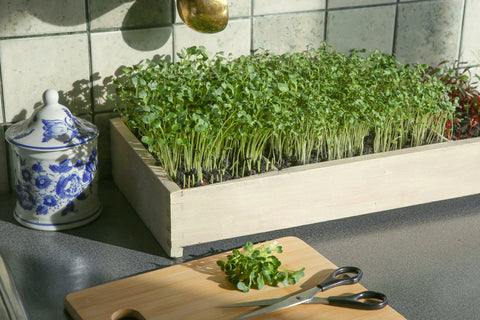Daily food items keep going from expensive to even more expensive. Everything you could want to buy from the market has become overpriced. Moreover, since the demand for organically grown produce is seeing a drastic increase, their prices have gone way up. In times like these, kitchen gardens have gained excessive popularity and with very good reason. Kitchen gardening isn't only convenient and healthy but also cost-effective. "You reap what you sow" is a phrase that definitely works here, because you can see the results after you put in the work.
Traditionally, kitchen gardens can be a separate part of your homes, grown with the purpose of having organically produced vegetables and other self-grown food at home. You can either attach these gardens closely to or grow them right outside your house.
• Benefits of Kitchen Gardening
1. Organic and healthy produce
Freshly grown crops provide added health benefits that can't be seen in any organically grown, mass-produced items. Any kitchen garden plants will bring in a quality that only you can ensure.
2. Environmental benefits
Who doesn't love increased oxygen production and cleaner air? With your kitchen garden, it will always be a plus. Additionally, you also reduce your carbon footprint by not needing someone to transport goods from the supplier to your house.
3. Responsible usage
Kitchen gardening produces food on a small scale. You use what you grow, and grow what you use. Since the cycle continues within a small circle, you reduce wastage and don't overbuy products that you may never make use of.
4. Adds aesthetic value
Kitchen gardens often stand to add a wonderful depth to your house. Giving it an added hint of life and creating a peaceful, calming environment for your mind to relax and possibly think more clearly than before.
• How To Begin?
Starting a kitchen garden can seem like a long and daunting process. But the reality is exactly the opposite. If you already have plants at home, the process of planting kitchen garden vegetables and fruits can be simpler than you think.
Some of the most important things you need to keep in mind while planting for kitchen gardening are the quality of soil, positioning, and layout. You can also create your own kitchen herb garden and significantly reduce the amount of items you buy from outside market.
1. Using the right kind of soil:
Different plants have different soil requirements, and keeping in mind these requirements is very important so that they can grow well. The soil used also has to provide good nutrition for any plant and has to allow it to grow the way it needs to.
2. Positioning and placement:
The way that some plants have specific soil requirements, and many of them also have varied environmental requirements. Some may require less sunlight than the rest and others may need to be given sunlight but will need more taking care of under any circumstances.
3. Layout:
You will need a solid layout for plant growth. Based on their environmental requirements, you can position them in ways they will best benefit from their surroundings. If you have a larger area available for kitchen gardening, you can spread out the plants accordingly and create enough space for them all. The layout should also allow you easy access to every plant.
4. Tools to keep on hand:
Any successful gardening endeavor will require tools that will be able to uphold all processes involved. Some tools can be substituted but there are others that you will absolutely need for your kitchen garden. Anything ranging from pots and planters to buckets and cans is an absolute necessity.
Rubber gloves, pruning shears, small-sized hand rakes, a trowel, shovels, a weeder, a hoe, and a gardening fork. A watering can and/or garden hose is also a must to keep your plants properly hydrated. If the area is relatively larger and surrounded by other large trees, a leaf blower would also come in handy. Garden scissors are also a basic necessity.
In most kitchen gardens, a rectangular shape is preferred over a square. Another small but important thing to keep in mind is that faster-growing and taller plants should ideally be planted in such a way that they don't shade the smaller ones.
• Vegetables and Fruits That you Can Grow for Kitchen Gardening
Tomato, chili, brinjal, bottle gourd, cucumber, radish are some commonly grown vegetables. Some fruits that are also easier for beginners to grow and care for are strawberries, lemons, guava, mango, and jamun.
Each one of your kitchen garden plants can be nurtured and grown to create a whole other world of fresh produce for you daily. Whatever your planting needs may be, Ugaoo has you covered. You can buy seeds online and start your journey with kitchen gardening to create healthier eating possibilities for yourself and the ones you love.

Buy Vegetable Seeds








